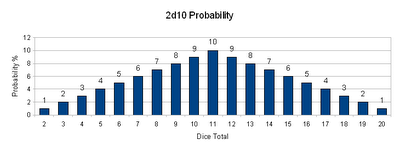Part Ia Character Creation compared
In this additional part I'll discuss character creation in more detail including the variant methods in RQII. I'll also compare the differences in how the three games treat character attributes.
Comparison
The use of 2D10 plus a fixed number that is used by WFRP gives a smaller effect even though it has a slightly wider range of results than the 3d6 used in C&C and RQII, given the WFRP's use of attribute scores as percentage amounts to be rolled.
The way that attributes affect resolution in C&C and RQ is stepped, e.g. if you have an attribute score of 12 in C&C it brings no positive modifier, but a 13 will give a +1 and a 16 +2 and an 18 +3. These are lower than the equivalent in 3rd edition D&D and base D20 games and in play are probably not quite so important though obviously having a positive modifier on any check helps.
Likewise in RQ a stat of 12 will normally bring no modifiers, but a 13 might bring a +5% and a 17 a +10%, in RQ these are not global modifiers for that statistic, but based on the particular application of the skill, e.g. Intelligence helps on attack, defence and knowledge rolls, but not on parrying. The Power statistic in RQ has a mixture of positive and negative effects for a high value, generally a power above 17 gives a +5% on most things, but makes a character harder to conceal because of their aura.
The difference between a score of 23 and 24 in WFRP is minimal (literally 1%), however for the derived values in the secondary profile of Strength Bonus and Toughness Bonus the main stat does make a difference as a score of 29 gives a SB or TB of 2, while a 30 gives a SB/TB of 3. This will affect the damage done in combat or the ability of a character to deal with wounds.
Comparing the three games and the degree of randomness in their character generation systems is fairly simple as RQ and C&C use 3d6 which gives the following bell curve/probabilities.

Warhammers 2D10 system gives a nice clean list of percentages, so for a human character any attribute can have the following values:
| 22 | 1% | 27 | 6% | 32 | 9% | 37 | 4% |
| 23 | 2% | 28 | 7% | 33 | 8% | 38 | 3% |
| 24 | 3% | 29 | 8% | 34 | 7% | 39 | 2% |
| 25 | 4% | 30 | 9% | 35 | 6% | 40 | 1% |
| 26 | 5% | 31 | 10% | 36 | 5% |

Shallya's mercy does mean that the average of attributes for characters is slightly higher than would happen if all rolls were taken as they fell, but only slightly as it raises a roll to the average for that character's race.
All three systems produce a bell curve so an "average" character is not outstandingly good at anything, but the most likely outcome with a random generation system is of a character having good and bad points which I personally like as creating scope for roleplay and determining the character using what has come out of the die rolling rather than starting with a concept and using a point buy system to try and make that character.
For in game effects Warhammer tends to be more granular with the percentage point differences on an Will or similar check while in C&C there will be the effect of the modifier giving a 5% step with each +/-1 and the very significant effect of primes which with the 6 point difference in the resolution score gives a +30% difference between a prime and non-prime attribute. RQ does not have the same tendency to make checks directly on attribute scores, but uses a stepped method with +/-5% increments on the resolution. On the whole I tend to prefer the RQ system, but all of these systems do work well in practice and these are not particularly big points of difference between these games and I'd need to compare to a very different mechanism like Savage Worlds or HeroQuest to see a major difference.
As a supplement to these first couple of posts I'm going to show character creation using the default method for all three sets of rules with each in an individual post.
RQ variant systems
The most significant of these is the points buy system which uses a flat value of 20 for the unallocated points with a base value of 8, so buying an 18 uses 10 points while a 14 takes 6 points. This was the first point buy character generation system I remember finding in an RPG, but I don't really remember using it as I preferred taking my chances with the dice. The other alternative systems still use some randomisation such as 2d6+6 or roll d20, though there is an option to use whatever system the GM wishes. I prefer the BRP system in Call of Cthulhu and RQIII with Intelligence and size as 2d6+6 as it avoids the hard to play low intelligence characters, unless the player and GM agree to use one for particular reasons.
The rest of the review can be found in these posts:
Part 1 Settings, Characters and Advancement
Part 1b Characters and Careers
Part 2 Equipment and Encumbrance
Part 3 Melee
Part 4 Magic
Part 5 Conclusions
No comments:
Post a Comment